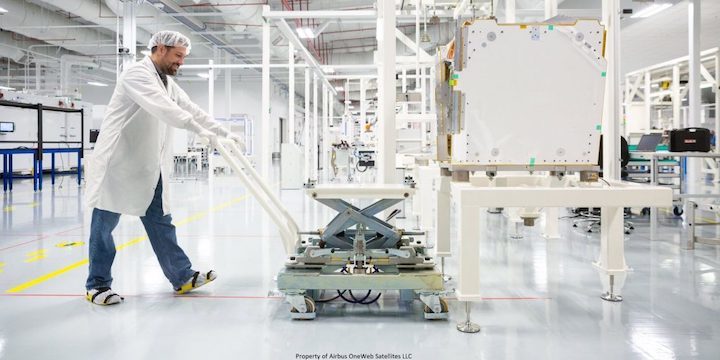13.03.2020

An executive says that SpaceX’s Seattle-based Starlink factory is building satellites up to four times faster than OneWeb, the company’s closest competitor in the new low Earth orbit (LEO) internet space race.
Speaking at the SATELLITE 2020 Conference on March 9th, Jonathan Hofeller – VP of Starlink and Sales – revealed SpaceX’s extraordinary Starlink production rate just days before the company’s sixth planned 60-satellite launch. Now two days away from liftoff with Falcon 9 and its satellite stack already vertical at the launch pad, SpaceX will likely end the week with some 350 operational satellites in orbit – around twice as many as any other public or private constellation in history.
While SpaceX will have soon attempted five 60-satellite Starlink launches in four months, CEO Elon Musk recently revealed that the company is still building spacecraft faster than it can launch them. At a reported production rate of six satellites per day, that news is now incredibly unsurprising given that it means SpaceX could theoretically build the world’s second-largest satellite constellation (excluding Starlink) in a single month. To be clear, though, the company has created one of the best possible problems the Starlink program could have.

First revealed in late 2019 and reiterated in recent months, SpaceX executives have consistently noted that the company plans to attempt some 20-24 dedicated Starlink launches in 2020 alone. As previously noted on Teslarati, 20-24 launches could put enough Starlink satellites in orbit for SpaceX to realistically begin serving customers almost anywhere on Earth.
“In recent months, SpaceX has indicated that Starlink will need at least 24 dedicated launches – 1440 satellites – to achieve uninterrupted global coverage, while as few as six launches (300 satellites) could enable service for customers in the northern US and southern Canada.
COO and President Gwynne Shotwell believes SpaceX can begin serving customers as early as mid-2020, ultimately maturing into an experienced internet service provider (ISP) in 2021. With almost 120 satellites already in orbit, if SpaceX can manage an average of 1.5 to 2 Starlink launches per month in 2020, the broadband internet constellation should have near-global coverage by the end of the year.”

Two and a half months into 2020, it’s entirely possible that SpaceX already has several launches worth of Starlink satellites waiting for their Falcon rockets. Weather and hardware-related delays have impacted each of the three 2020 Starlink launches SpaceX has completed thus far, pushing its internal manifest back by at least several weeks. SpaceX could be strategically slowing work at its factory based on predictions of rocket availability in the next few months, avoiding a massive stockpile of Starlink satellites. Still, it’s just as likely that its Seattle HQ has been churning out several satellites per day for weeks or even months. Even if SpaceX has only averaged four satellites per day over the last three months, it would likely have a backlog of 4+ launches (~240 satellites).

Compared to OneWeb, SpaceX Starlink satellites thus weigh 75% more, offer at least 50% more bandwidth for internet services, can be manufactured for less than half the cost in a quarter of the time, and likely cost – per satellite – at least three times less to launch. These are the fundamental, unavoidable benefits of SpaceX’s preferred strategy of vertical integration writ large. End-product quality and functionality held equal, it’s numerically impossible for a more traditional company like OneWeb to compete head-to-head with a vertically-integrated competitor like SpaceX.
Thankfully, though, the supply for LEO-based internet services is currently so small – and the demand so large – that OneWeb will almost certainly be able to find a niche and survive. For now, the fact remains that SpaceX is all but guaranteed to continue building and launching far more satellites than OneWeb — all for a dramatically lower cost.
Quelle: TESLARATI
